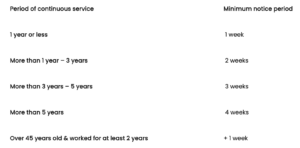Employment Termination Checklist
Dismissing an employee or being dismissed can be a complicated time for all involved. Our Employment Termination Checklist may be helpful in ensuring you have met all the legal requirements if you are considering this process or have already begun it. It will also ensure a smooth transition as much as possible.
Make sure the employee is being terminated for a valid reason

In Australia there are laws governing the reasons an employee may be terminated. The lawful reasons an employee may be terminated are:
-
- Redundancy – the position is no longer required due to lack of demand, technological advances or the insolvency of the employer;
- Lack of Competency – the employee’s work has not been adequate;
- Serious Misconduct – the employee has engaged in theft, assault, fraud or other conduct that puts the health and safety of other employees at risk or is inconsistent with his or her continued employment; or
- Mutual agreement between the employee and employer.
There are many reasons that would be unlawful to terminate an employee for. These include:
-
- Because of the employee’s gender, marital status, sexual orientation race, age, colour, pregnancy. Termination of employment for these reasons could potentially lead to a discrimination claim;
- Because the employee has exercised a protected employment right, like:
- taking sick leave
- taking parental leave
- requesting flexible working arrangements
- filing a Worker’s Compensation Claim
- making a complaint or enquiry regarding their employment, or
- taking part in an Industrial Action against the employer.
Make sure that the employee has been fairly dealt with
It is important that during the termination process, the employee is dealt with fairly by the employer. The employee can make an Unfair Dismissal or General Protections claim through the Fair Work Commission if the employer does not exercise procedural fairness during the termination process.
Please note that there are certain circumstances where you cannot claim through the Fair Work Commission, if you work for State government or are subject to employment contracts within high income threshold.
To avoid this, the employer must:
-
- Warn the employee of any concerns the employer has about his or her performance before deciding to terminate the employee’s employment;
- Give the employee adequate opportunity to respond to these concerns;
- Thoughtfully consider whether there are alternatives to dismissal, such as training or redeployment; and
- Grant any reasonable requests by the employee to have a support person present at discussions regarding the employee’s ongoing employment.
In all circumstances the dismissal must not be able to be construed as harsh, just or unreasonable.
Small Businesses (those employing less than 15 people) can seek to avoid Unfair Dismissal claims by following the Small Business Fair Dismissal Code Checklist.
Make sure the employee has been given adequate notice
The employer must give notice as to when the termination will take effect once they have decided to terminate an employee. This notice MUST be given in writing to the employee or sent to their last known address. The notice period is the time between when notice is given and the last day of the employment and the length of notice required will be determined by either the provisions of the applicable employment contract, or otherwise as set out by the National Employment Standards, as set out below.
How much notice is required?
There are some specific circumstances where no notice is required. These include:
-
- Where an employee is employed for a specified period of time, for a specified task, or for the duration of a specified season;
- Where an employee is terminated because of serious misconduct (for example, an employee who has, in the course of their employment, engaged in theft, fraud or assault);
- Where an employee is a casual employee;
- Where an employee (other than an apprentice) is limited to the duration of the training arrangement; and
- Where (in some circumstances) the employee is a daily or weekly hire employee.
Once the employee has been given notice, they can serve the notice period or be “paid out” for the notice period, at the discretion of the employer. If they are paid out they must receive their normal pay rate for their normal hours for the designated notice period in lieu of serving their notice period in the workplace.
Make sure the employee has received the correct amount of pay
Employers have to fulfil their obligation to pay out employees upon termination and the amount depends on the individual situation. Many employees are entitled to a lump sum payout made up of outstanding wages, accrued annual leave, long service leave (where applicable) and/or redundancy pay.
If you are need assistance in navigating the termination process, you should contact a lawyer as soon as possible. Strict time limits do apply from the date of termination. Contact our Client Engagement Team on 07 3252 0011 or email us today to make an appointment.